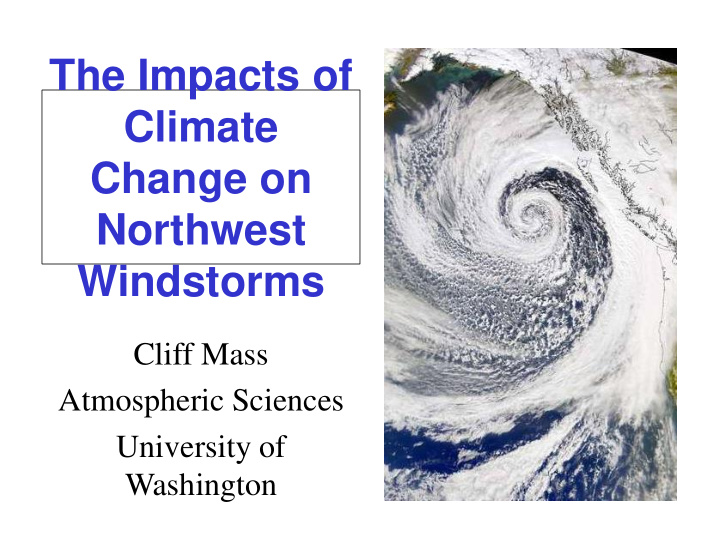



The Impacts of Climate Change on Northwest Windstorms Cliff Mass Atmospheric Sciences University of Washington
Although the Pacific Northwest does not experience tropical storms or hurricanes, we do experience very strong Pacific cyclones, with winds equal to category two or three hurricanes 1993 Inauguration Day Storm
The Thunderbird Native Americans knew about NW windstorms and had several legends regarding their origin.
John Meares, 1788, off of Cape Flattery of the Olympics Peninsula The force of southerly storms was evident to every eye; large and extensive woods being laid flat by their power, the branches forming one long line to the North West, intermingled with the roots of innumerable trees, which have been torn from their beds and helped to mark the furious course of their tempests.
Early Settlers • As European settlers learned that Northwest windstorms were a force to be reckoned with. • In 1875, Seattle pioneer Arthur Denny noted "a strong gale, Arthur Denny which threw down considerable timber and overturned light structures, such as sheds and outbuildings. ” Seattle
Big Trees: NW Storm Force Multiplier A minor windstorm Easter Sunday, April 97
Compared to this…
Most Northwest Windstorms are Produced by Midlatitude Cyclones with low central pressures • A cyclone is an area of low pressure around which air circulates in a counterclockwise direction (in the northern hemisphere)
Midlatitude Cyclones • The lower the central pressure the stronger the winds. • Typical winter low 990-1000 hPa. Moderate windstorms 980-990 hPa. Strong ones, 950- 980hPa • Deep lows have strong pressure gradients, which result in the strong winds.
Weather Satellites Imagery of Our Storms Reveal The Huge Scale of Our Major Storms
Tropical Cyclones: Much Smaller
Pressure Pattern Associated with the Chanukah Eve Storm Chanukah Eve Storm: 18-h forecast for 10 PM December 14, 2006 Of December 15, 2006 L
The Most Extreme Northwest Windstorm: The Columbus Day Windstorm of 12 October 1962
Began as Typhoon Frieda and then moved northward and transformed into a midlatitude cyclone.
Columbus Day Storm • The most damaging windstorm to strike the Pacific Northwest in 150 years. • An area from northern California to southern British Columbia experienced hurricane-force winds , massive treefalls, and power outages. • In Oregon and Washington, 46 died and 317 required hospitalization as a result of the storm.
Max Winds (mph) Columbus Day Storm 1962
Columbus Day 1962: At Cape Blanco there were 150 mph with gusts to 179! Strongest winds on bluffs and windward slopes of coastal orography
More Recent Storms
Inauguration Day Storm January 20, 1993
The first major windstorm to be highly skillfully forecast….
Winds of over 100 mph were observed at exposed sites in the coastal mountains and the Cascades, with speeds exceeding 80 mph along the coast and in the interior of western Washington.
Chanukah Eve Storm of Dec. 2006
• Winds gusted to 90 mph along the coast, 80 mph in the eastern Strait of Juan de Fuca, and 70 mph over the Puget Sound lowlands. • In the Cascades, winds reached 100 mph at Sunrise on Mt. Rainier and 113 mph at Chinook Pass.
Pacific Cyclone Key Facts • Each year, typically get several storms with winds gusting to 30-50 mph. • Every year, a storm reaching roughly 50-70 mph. • Every ten years, 70-90 mph • Every 30-50 years, 90+ in exposed locations.
A Winter Season Phenomenon
Northwest Windstorms and Global Warming • Will there be more of them? • Will they become more intense? The Inauguration Day Storm 1993
Northwest Windstorms • The best science suggests that there will not be an increasing trend. • But first, what has been the trend over the past half-century?
Seattle City Light sponsored study • Started with global climate models • Used regional, high-resolution models to look at local impacts.
Number of times above 90 percentile for 1970-2000 (DJF) Just offshore of Washington Coast
Seattle
Why SHOULD we expect Northwest windstorms to change? • Their energy source is the jet stream and the strong horizontal temperature gradients associated with it. • Most global climate models suggest that the temperature gradients will weaken at low levels as the Arctic heats up more than the poles. • But the temperature gradient increases in upper troposphere.
Hurricanes hitting the Northwest under Global Warming? Forget it, even a warmed eastern Pacific will be far too cold.
Observed Trend at Sea-Tac
Damaging Winds Can Also Be Produced in other Ways Gaps in Our Terran Produce Strong Wins.
Enumclaw and nearby foothills locations can experience severe windstorms…while calm winds occur a dozen miles away Winds over 118 mph December 24, 1983
December 24, 1983
Why Enumclaw?
Enumclaw Windstorm Pressure Pattern December 24, 1983
Fraser River Gap Windstorms December 28, 1990
Fraser River NE Gap Flow Max Winds, 28 Dec. 1990 Gusts above 90 mph
What will Global Warming Do to Strong Gap Winds? • Probably weaken them • Cold air in the interior of the continent results in higher pressure that can help drive gap winds • Global warming is lessening the severity of the cold air in the interior. • Less strong offshore flow in gaps during winter.
Cold Wave Trends The U.S. Environmental Protection Agency did a study of the trend of cold wave days from 1948 to 2015
An Aside: Forecasting of Northwest Windstorms is MUCH Better • Better forecast models • Satellite data around the globe • Higher resolution and more. • Before ~1993 we got most wrong. Today, most correct days in advance.
Forecasts Need to Be Used Better in Construction
Seattle WindWatch
Bottom Line • There is no reason to expect increased extreme winds over the region under global warming. • Weather forecasting skill has improved, which can be useful for protecting construction and buildings in place.
Recommend
More recommend